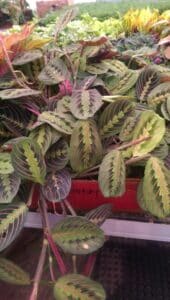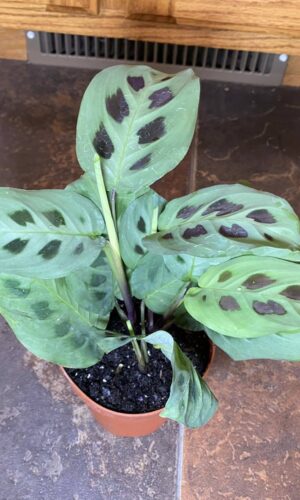
AKA Prayer Plant
The Prayer plant, native to Brazil. Asia, and Africa, is a very unique plant. The large patterned leaves with hues of red, green, brown, and cream, lift up and fold together each evening as though praying and open again the next morning.
Prayer plants do well in medium to high light, but no direct sun. When there is not enough light, the leaves close at night and do not fully open during the day. When a Prayer plant gets too much light, the color in the leaves starts to fade.
Keep the soil of a Prayer plant moist but never soggy. Unlike most houseplants, it does not like to dry out before you water.
A Prayer plant prefers normal household temperatures between 60°-80°. Lower temperatures can damage the leaves.
A Prayer plant likes a very humid environment, and the humidity in ours homes is often too low. Increase the humidity by grouping plants together, putting a small humidifier or bowl of water near the plant, or setting a Prayer plant on a tray filled with water and small stones. Be sure the plant is sitting on the pebbles and not in the water.
Mealy Bugs, spider mites, and Aphids are Plant Pests that can attack a Prayer plant.
The high humidity a Prayer plant needs encourages Leaf Spot Disease.
Prayer plants do best in a well-aerated, peat based, indoor potting soil that retains water yet still drains quickly.
These plants have very shallow roots. Always plant a Prayer plant in shallow pots with drip holes in the bottom.
Pruning a Prayer plant consists mainly of trimming the stems twice a year to keep the plant compact and bushy.
This is a popular gift for funerals because of the way the leaves close at night and unfold the next morning, as though the plant were praying.
A Prayer plant is a non- poisonous houseplant.

